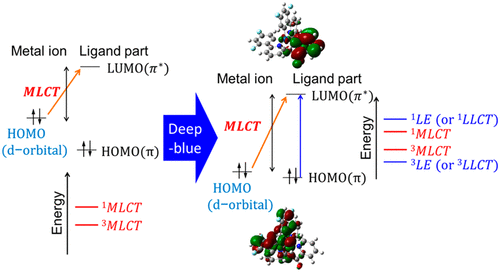当前位置:
X-MOL 学术
›
Organometallics
›
论文详情
Our official English website, www.x-mol.net, welcomes your feedback! (Note: you will need to create a separate account there.)
Advancing the a Posteriori Quest for Deep-Blue Phosphorescence: Quantifying Excitation-Induced Metal-to-Ligand Charge Transfer as a Guiding Indicator
Organometallics ( IF 2.8 ) Pub Date : 2020-11-10 , DOI: 10.1021/acs.organomet.0c00506 Masahito Oh-e, Akira Nagasawa
Organometallics ( IF 2.8 ) Pub Date : 2020-11-10 , DOI: 10.1021/acs.organomet.0c00506 Masahito Oh-e, Akira Nagasawa

|
To advance the a posteriori quest for deep-blue phosphorescence, we quantify the degree of metal-to-ligand charge transfer (MLCT) upon excitation using density functional theory calculations. We also comprehensively determine how the MLCT nature of a state is correlated with the wavelength of potential phosphorescence through comparing the results of two typical ligand structures, i.e., 2-phenylpyridine and 1-phenyl-3-methylimidazolin-2-ylidene, with those of their derivatives. The MLCT nature can be defined as the difference in the electron density over the central metal ion that contributes to the highest occupied and lowest unoccupied molecular orbitals (HOMO and LUMO, respectively). This study focuses on how the MLCT nature can be characterized upon excitation depending on the admixtures of molecular orbitals and how a stronger MLCT nature is preferable for efficient phosphorescence, while the MLCT nature exhibits a trade-off relationship with the wavelengths of phosphorescence in the blue region. Moreover, we elucidate how iridium(III) complexes are suitable for efficient phosphorescence and discuss a conceptual grand design for transition-metal complexes with deep-blue phosphorescence using the ligand field theory. We examine why strong MLCT nature upon excitation does not necessarily ensure highly efficient phosphorescence, taking into account possible relative energy gaps between the singlet MLCT, triplet locally excited, and d–d transition states in a transition-metal complex formed after excitation. Nevertheless, the initial MLCT serves as a necessary condition that induces corollary energy-state configurations as well as decay from the excited states. Therefore, quantifying the nature of that MLCT, which is the first process upon excitation, with the possible wavelength of phosphorescence is a useful parameter for a conceptual grand design for candidate complexes that can efficiently emit deep-blue phosphorescence. This reverse method of analyzing candidate complexes before experimentally formulating and studying them can accelerate the a posteriori quest for deep-blue-emitting materials.
中文翻译:

推进深蓝色磷光的后验探索:量化激发诱导的金属到配体的电荷转移作为指导指标
为了推进对深蓝色磷光的后验探索,我们使用密度泛函理论计算了激发后金属到配体电荷转移(MLCT)的程度。我们还通过比较两种典型的配体结构(即2-苯基吡啶和1-苯基-3-甲基咪唑啉-2-亚基)的结构结果,全面确定了状态的MLCT性质与潜在磷光波长之间的关系。他们的衍生物。MLCT性质可以定义为中央金属离子上电子密度的差异,该差异导致最高的未占用分子轨道和最低的未占用分子轨道(分别为HOMO和LUMO)。这项研究着眼于如何根据分子轨道的混合物根据激发来表征MLCT性质,以及对于有效的磷光而言,更强的MLCT性质对于可取的磷光是优选的,而MLCT性质与蓝色磷光的波长表现出权衡关系地区。此外,我们阐明了铱(III)配合物如何适用于有效的磷光,并使用配体场论讨论了具有深蓝色磷光的过渡金属配合物的概念总体设计。考虑到单线态MLCT,三线态局部激发和单线态MLCT之间可能的相对能隙,我们研究了激发后强大的MLCT性质为何不一定能确保高效磷光。而MLCT的性质与蓝色区域中磷光的波长表现出权衡关系。此外,我们阐明了铱(III)配合物如何适用于有效的磷光,并使用配体场论讨论了具有深蓝色磷光的过渡金属配合物的概念设计。考虑到单重态MLCT,三重态局部激发和 而MLCT的性质与蓝色区域中磷光的波长表现出权衡关系。此外,我们阐明了铱(III)配合物如何适用于有效的磷光,并使用配体场论讨论了具有深蓝色磷光的过渡金属配合物的概念总体设计。考虑到单线态MLCT,三线态局部激发和单线态MLCT之间可能的相对能隙,我们研究了激发后强大的MLCT性质为何不一定能确保高效磷光。激发后形成的过渡金属络合物中的d – d过渡态。尽管如此,初始MLCT仍是诱发推论能态构型以及从激发态衰变的必要条件。因此,用可能的磷光波长量化作为激发的第一个过程的MLCT的性质,对于可以有效发射深蓝色磷光的候选配合物的概念总体设计,是一个有用的参数。这种在实验性配制和研究前对候选复合物进行分析的反向方法可以加快对后发深蓝光材料的要求。
更新日期:2020-11-23
中文翻译:

推进深蓝色磷光的后验探索:量化激发诱导的金属到配体的电荷转移作为指导指标
为了推进对深蓝色磷光的后验探索,我们使用密度泛函理论计算了激发后金属到配体电荷转移(MLCT)的程度。我们还通过比较两种典型的配体结构(即2-苯基吡啶和1-苯基-3-甲基咪唑啉-2-亚基)的结构结果,全面确定了状态的MLCT性质与潜在磷光波长之间的关系。他们的衍生物。MLCT性质可以定义为中央金属离子上电子密度的差异,该差异导致最高的未占用分子轨道和最低的未占用分子轨道(分别为HOMO和LUMO)。这项研究着眼于如何根据分子轨道的混合物根据激发来表征MLCT性质,以及对于有效的磷光而言,更强的MLCT性质对于可取的磷光是优选的,而MLCT性质与蓝色磷光的波长表现出权衡关系地区。此外,我们阐明了铱(III)配合物如何适用于有效的磷光,并使用配体场论讨论了具有深蓝色磷光的过渡金属配合物的概念总体设计。考虑到单线态MLCT,三线态局部激发和单线态MLCT之间可能的相对能隙,我们研究了激发后强大的MLCT性质为何不一定能确保高效磷光。而MLCT的性质与蓝色区域中磷光的波长表现出权衡关系。此外,我们阐明了铱(III)配合物如何适用于有效的磷光,并使用配体场论讨论了具有深蓝色磷光的过渡金属配合物的概念设计。考虑到单重态MLCT,三重态局部激发和 而MLCT的性质与蓝色区域中磷光的波长表现出权衡关系。此外,我们阐明了铱(III)配合物如何适用于有效的磷光,并使用配体场论讨论了具有深蓝色磷光的过渡金属配合物的概念总体设计。考虑到单线态MLCT,三线态局部激发和单线态MLCT之间可能的相对能隙,我们研究了激发后强大的MLCT性质为何不一定能确保高效磷光。激发后形成的过渡金属络合物中的d – d过渡态。尽管如此,初始MLCT仍是诱发推论能态构型以及从激发态衰变的必要条件。因此,用可能的磷光波长量化作为激发的第一个过程的MLCT的性质,对于可以有效发射深蓝色磷光的候选配合物的概念总体设计,是一个有用的参数。这种在实验性配制和研究前对候选复合物进行分析的反向方法可以加快对后发深蓝光材料的要求。


























 京公网安备 11010802027423号
京公网安备 11010802027423号